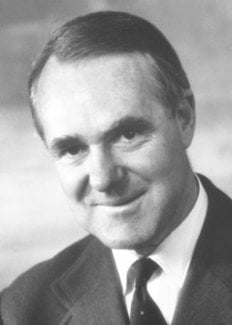John Cornforth
Biographical

I was born on 7 September 1917 at Sydney in Australia. My father was English-born and a graduate of Oxford; my mother, born Hilda Eipper, was descended from a German minister of religion who settled in New South Wales in 1832. I was the second of four children.
Part of my childhood was spent in Sydney and part in rural New South Wales, at Armidale. When I was about ten years old the first signs of deafness (from otosclerosis) became noticeable. The total loss of hearing was a process that lasted more than a decade, but it was sufficiently gradual for me to attend Sydney Boys’ High School and to profit from the teaching there. In particular a good young teacher, Leonard Basser, influenced me in the direction of chemistry; and this seemed to offer a career where deafness might not be an insuperable handicap.
I entered Sydney University at the age of 16, and though by that time unable to hear any lecture I was attracted by laboratory work in organic chemistry (which I had done in an improvised laboratory at home since the age of 14) and by the availability of the original chemical literature. In 1937 I graduated with first-class honours and a University medal. After a year of post-graduate research I won an 1851 Exhibition scholarship to work at Oxford with Robert Robinson. Two such scholarships were awarded each year, and the other was won by Rita Harradence, also of Sydney and also an organic chemist. This began an association which continues to this day. We were married in 1941, and have three children and two grandchildren.
War broke out as we journeyed to Oxford and after completing our work (on steroid synthesis) for doctorates we became part of the chemical effort on penicillin which was the major chemical project in Robinson’s laboratory during the war. We made contributions, and I helped to write The Chemistry of Penicillin (Princeton University Press, 1949), the record of a great international effort. However, I had earlier discovered what was to prove a key reaction for the synthesis of the sterols; and after the war I returned to this pursuit. The collaboration with Robinson continued after I joined (1946) the scientific staff of the Medical Research Council and worked at its National Institute, first at Hampstead and then at Mill Hill. In the end (1951) we were able to complete, simultaneously with Woodward, the first total synthesis of the non-aromatic steroids.
At the National Institute for Medical Research I came into contact with biological scientists and formed collaborative projects with several of them. In particular George Popják and I shared an interest in cholesterol. At this time Konrad Bloch was beginning his work on the biosynthesis of the sterols and Popják and I began to concert experiments in which the disciplines of chemistry and biochemistry could be applied to this subject. We were led to devise a complete carbon-by-carbon degradation of the nineteen-carbon ring structure of cholesterol and to identify, by means of radioactive tracers, the arrangement of the acetic acid molecules from which the system is built. As knowledge of the intermediate stages became more complete our experiments could be planned to give more and more information.
In 1962 Popják and I left the service of the Medical Research Council and became co-directors of the Milstead Laboratory of Chemical Enzymology set up by Shell Research Ltd. Lord Rothschild was influential in the decision to establish this laboratory and I was his subordinate until he left Shell in 1970. At Milstead a project already conceived – the study of the stereochemistry of enzymic reactions by means of asymmetry artificially introduced by isotopic substitution – was developed. It continued after 1968, when Popják left Milstead to go to the University of California at Los Angeles, until 1975, when I left to take up my present position of Royal Society Research Professor at the University of Sussex. In 1967 I had formed a collaboration with Hermann Eggerer, then of München; and together we solved the problem of the “asymmetric methyl group”, and applied the solution in some of the many ways that have proved possible.
My work has received ample recognition as it progressed: I was elected to the Royal Society in 1953; the Chemical Society has awarded me its Corday Morgan medal (1953), Flintoff medal (1965), and Pedler (1968) and Robert Robinson (1971) lectureships; the American Chemical Society gave me its Ernest Guenther award (1968); and I received the Prix Roussel in 1972. Popják and I were jointly awarded the Biochemical Society’s Ciba medal (1965); the Stouffer prize (1967); and the Royal society’s Davy Medal (1968).
Throughout my scientific career my wife has been my most constant collaborator. Her experimental skill made major contributions to the work; she has eased for me beyond measure the difficulties of communication that accompany deafness; her encouragement and fortitude have been my strongest supports.
This autobiography/biography was written at the time of the award and later published in the book series Les Prix Nobel/ Nobel Lectures/The Nobel Prizes. The information is sometimes updated with an addendum submitted by the Laureate.
John Cornforth died on 8 December 2013.
Nobel Prizes and laureates
See them all presented here.
